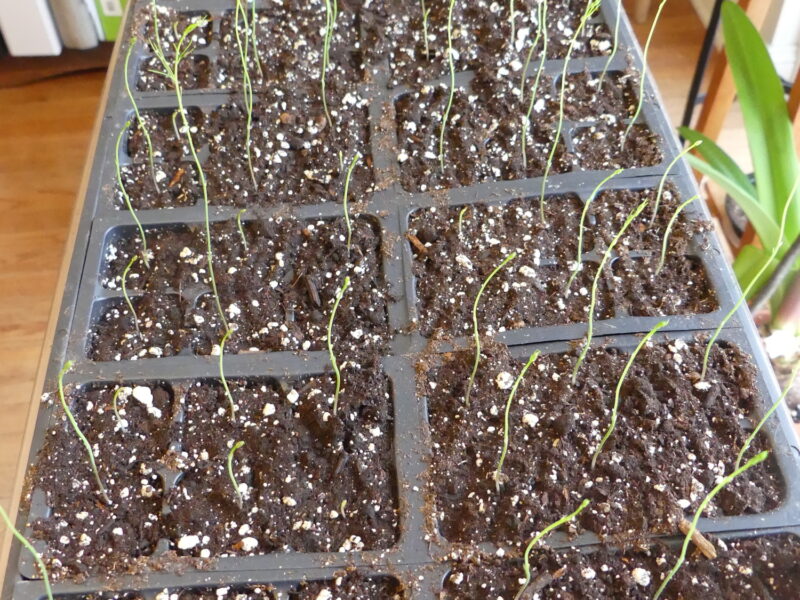

There are only a few things we can grow in our vegetable gardens that are perennials, and only one of them, when planted correctly, will outlive you. This is the mighty asparagus, and now — right now — is the time to plant.
But a vegetable that will perform for you and your next generations needs special planting and a bit of understanding before it will bear its delicious spears. And for the first year or two you will have to control your temptation. If you do, it will produce forever.
Asparagus is planted using 1- or 2-year-old “crowns” that you can buy at a local garden center or online from a source like johnnyseeds.com, where you can buy 25 crowns for about $44. Green varieties are spaced on 8-to-14-inch centers while the purple varieties are spaced on 6-to-8-inch centers. However, there’s more to this than just planting. And yes, you can grow asparagus from seed, but this effort will take four or more years to have your first crop. More on this later.
Since asparagus crowns are planted in beds or rows that will last and be productive for years and years, you only get one chance to prep the beds and there should be no skimping here. Cheat on this aspect and your yields will be meager, and the beds won’t be productive for long at all. It’s especially important out on the East End with our sandy soils. This plant likes good drainage, but it thrives on a rich, organic soil where the roots can go deep and wide.
To give you an example of the results you can get with the right bed and soil preparations, there’s a bed in England that was planted 178 years ago by Sir Joseph Hooker, who was the curator of Kew Gardens. That bed is still in production and doing just fine.
Before we get to the bed digging and preparation you need to understand a few things about this perennial vegetable. You can buy crowns that are 1 or 2 years old. It will take two years for a 1-year-old crown to be productive and one year for the 2-year-old crowns to begin producing. Even then, your first harvest should be a thin one as the spears you leave behind to grow their airy, fern-like foliage are what will “feed” the roots that will ensure years of copious production. It’s so worth the wait. There is store-bought asparagus, and there’s asparagus cut fresh from your garden. There is absolutely no comparison in taste. None. But the season is short.
Start by finding the right place for your bed or rows. Some gardeners like to put their asparagus planting in a spot away from other areas because of the room required, but no matter where you put them they will need full sun for most of the day. I have two spots where I grow asparagus, but in reality it grows in many spots since I allow some of my plants to flower (white, tiny star-shaped flowers) and go to seed (bright red). As the seed fruits ripen, birds and chipmunks seem to move the seed around, and it germinates in other areas. This results in what are essentially asparagus ferns, similar to the ones we grow as houseplants, popping up in other areas. I don’t harvest them but leave them as ornamental plants.
Your bed will need to be dug deep, and the soil amended, then once the bed is set you won’t disturb it at all other than some weeding. Asparagus hates weed competition. Start by digging a trench at least 12 inches deep and 18 inches wide, and if you are planning more than one trench they should be 4 feet apart center to center. Once the trench is dug, use a spading fork and loosen the soil at the bottom to a depth of 8 to 10 inches. Add about half a pound of 10-10-10 fertilizer to every 10 feet of the trench and work this into the soil. Asparagus likes a neutral soil with a pH of about 7. If your soil is too acidic you can add ground (slow acting) limestone. Next, add about 4 inches of well-rotted compost or well-composted manure to the bottom of the trench. This will provide nutrients to the plants in their early years.
Spade or till (a mini tiller is perfect for this) the material so it’s homogenous, and this becomes your “base” for the asparagus plants. Gently firm the soil (firm, don’t compact) and you are ready to plant your crowns in the remaining trench, which will now be about 8 inches deep. Take your asparagus crowns and stretch out the roots like they’re the tentacles of an octopus. Space the roots on 8-to-14-inch centers as described earlier and gently cover the crowns with 2 inches of fine garden soil. Then every few weeks add another 2 inches of soil until the bed is topped off.
Three months after planting you can side dress the trench (at the edges) with a balanced organic granular fertilizer adding the equivalent of about 1 cup for every row-foot. Two years after planting your 1-year-old crowns (or 1 year after planting your 2-year-old crowns) you can begin to harvest.
Your first harvest should be a thin one, never removing more than half the spears that should be 8 to 10 inches tall. Spears that get taller should be allowed to continue to grow and flower as these will continue to feed the roots. In succeeding years never harvest all the spears, always leaving a few at each crown to feed the roots. The spears grow quickly so don’t skip a day or two or they’ll begin to get away. Add an organic side dressing of 5-10-5 or 10-10-10 annually after harvest, then again in late July or early August. Always side dress and never put the fertilizer directly over the bed.
If you’ve got the time you can grow your asparagus from seed. This process can take five years, but it’s inexpensive and you can harvest your own seed from the plants you let go to flower or buy the seed (Johnny’s sells the seed as well). You can start the seed in May in cells and transplant the seedlings to the bed in August or September.
I’ve never had a disease issue with my asparagus, but from time-to-time asparagus beetles may show up. They’re easy to spot since they’re orange with 10 to 15 black spots on their backs. Simply pick them off and drop them into a small container.
One last thing. Catalogs and growers used to make a big thing about male and female asparagus plants. The theory was that since the males don’t put energy into flower production they taste better. I haven’t found this to be true. It seems that most of my asparagus plants are females and if allowed to flower, they will. But, since most are harvested well prior to flowering they never get to that stage and no one has ever complained about the taste of my spears. However, male plants may indeed produce thicker spears. Keep growing.
 More Posts from Andrew Messinger
More Posts from Andrew Messinger